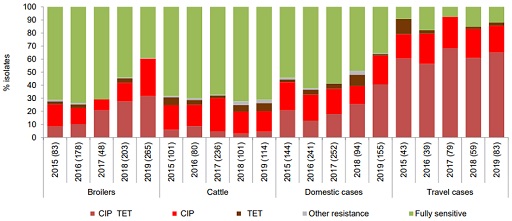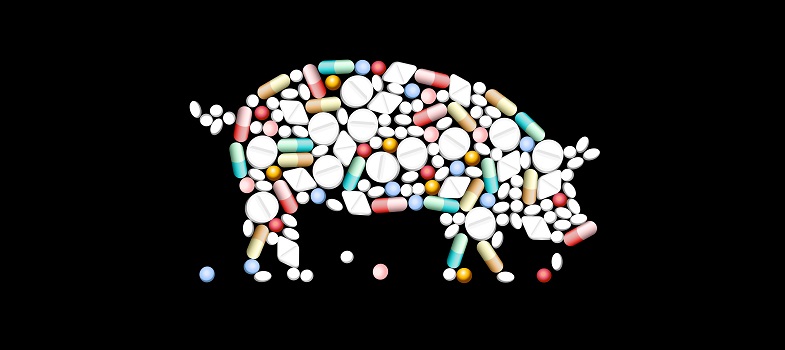2.2.2 Benefits to public health
AMR surveillance activities can also have a public health benefit, if the focus is foodborne pathogens and zoonotic bacteria in animals. As explained in the module Antimicrobial resistance in animals, zoonotic bacteria are transmitted between animals and humans, and cause infection in humans. These can be commensal bacteria in animals, so surveillance activities need to target healthy animals at the farm or abattoir, and animal products in the food chain.
In Sweden, there is active screening for E. coli with resistance to extended spectrum cephalosporins, collecting faecal samples in healthy food animal species in farms, in abattoirs and meat samples in retail. The bacterial isolates with reduced susceptibility to cephalosporins were further investigated by genome sequence for the presence of transferable genes coding ESC resistance, and regularly compared to clinical human E. coli isolates. Few isolates from different sources were reported to present resistance to more than one antibiotic (that is, multiresistant); however, no transferable genes coding for ESC were detected (Aspevall et al., 2020).
Also in Sweden, clinical E. coli isolates from passive surveillance in animals and humans are compared to identify potential common resistance. Challenges were described in these systems due to the different type of cut-off value used. Data for bacteria from humans are interpreted with clinical breakpoints, as the minimum inhibitory concentration (MIC) of antibiotics that is effective in more than 80% of cases, in patients with infectious diseases and presented as the proportion of isolates with clinical resistance. In contrast, data for bacteria from animals are mainly interpreted with epidemiological cut-off values (ECOFF) and presented as the proportion of isolates of non-wild type. A EUCAST report [Tip: hold Ctrl and click a link to open it in a new tab. (Hide tip)] explains how to use the equivalence between the different information (EUCAST, n.d.). More details about the surveillance activities, analytic methods and interpretation of results can be found in SWEDRES/SVARM 2019. (Aspevall et al., 2020).
In Denmark, the Danish Integrated Antimicrobial Resistance Monitoring and Research Programme (DANMAP) includes surveillance of Campylobacter spp. and non-typhoidal Salmonella spp. with the aim of establishing trends and sources of resistance. The system collects information from chicken, cattle and humans. More details on the characteristics of surveillance can be found in the DANMAP report (Korsgaard et al., 2020).
Figure 6 shows resistance profiles of Campylobacter jejuni across the different species, comparing the distribution of resistance. Some noticeable features include the following:
- The highest percentage of resistant C. jejuni isolates to both ciprofloxacin and tetracycline was from humans returning from overseas.
- The percentage of resistant C. jejuni to both ciprofloxacin and tetracycline has increased in broilers and human domestic cases in the last years.
- In cattle, the main resistance found was to ciprofloxacin. It is important to note that fluoroquinolones (which include ciprofloxacin) have not been used in Denmark for animal production for ten years.
Whole genome sequencing from the isolates was applied only to human isolates that allowed the investigation of a nationwide outbreak due to a common C. jejuni clone resistant to ciprofloxacin, nalidixic acid and tetracycline. However, establishing the role of outbreaks in general resistance trends remains a challenge.

Figure 6 Distribution (%) of AMR profiles in Campylobacter jejuni from broilers, cattle and human cases in Denmark, 2015–19. The number of isolates included each year is shown in parentheses, where broilers include isolates from Danish broiler meat. (CIP = all isolates with ciprofloxacin resistance but not tetracycline resistance; TET = all isolates with tetracycline resistance but not ciprofloxacin resistance; CIP TET = all isolates with both ciprofloxacin and tetracycline resistance; other resistance = all isolates without both ciprofloxacin and tetracycline resistance. CIP TET, CIP and TET isolates may be resistant to erythromycin, nalidixic acid or streptomycin.)
Show description|Hide descriptionThe trend over 2015–19 is that the distribution of CIP TET AMR profiles in broilers and domestic cases have increased at the expense of fully sensitive distribution; in cattle and travel cases, the distribution has remained fairly consistent.




